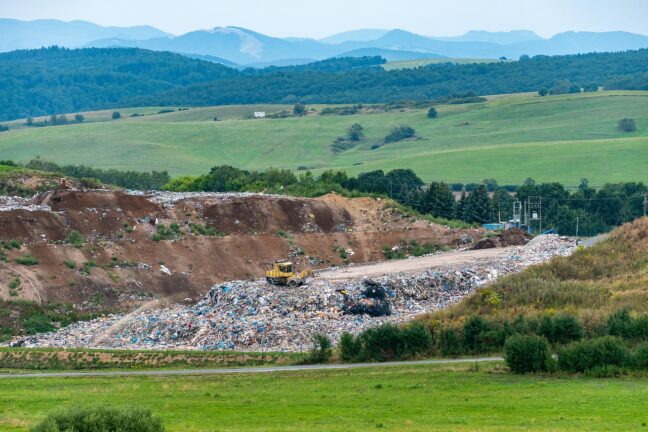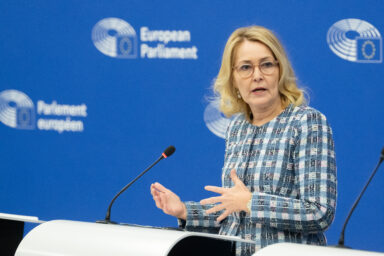“Garbage. All I’ve been thinking about all week is garbage. I mean, I just can’t stop thinking about it.” That line, delivered with weary sincerity by actress Andie MacDowell in sex, lies, & videotape all the way back in 1989, was existential, a sign of inner turmoil. Today, across the Atlantic and beyond, it feels all too literal. Decades later, Europe’s waste landfills have only grown — and with it the urgency to act.
Food and textiles together account for a staggering share of the European Union’s waste problem. Together, they make up around 20 per cent of all waste generated in the EU — with an estimated 60 million tonnes of food discarded every year and 12.6 million tonnes of textiles ending up in landfills. Beyond the mountains of garbage, both sectors carry disproportionately high environmental and social costs. With the revised Waste Framework Directive in force since 15 October 2025, the EU is finally cracking down.
For the first time ever, the EU is imposing binding targets on the food and textile industries to significantly reduce food waste and fast fashion landfill overflow. This marks a turning point from vague commitments — demanding real change from producers, retailers, and consumers alike. With these new rules, two of Europe’s biggest waste challenges come under the microscope.
Sustainable management of textile waste
The EU’s textile and clothing sector is a major economic force, generating a turnover of €170bn in 2023 and employing 1.3 million people across 197,000 companies. Yet, the environmental footprint of textile production and consumption is severe. In 2020, the textile sector ranked third highest in water and land use, and fifth in raw material use and greenhouse gas emissions within the EU, the Commission reported.
Textile waste, too, remains a mounting concern. Approximately 12.6 million tonnes were generated in 2019 alone, but only about one-fifth was separately collected for reuse or recycling. To address this, the revised Waste Framework Directive introduced two key measures designed to reduce waste while enhancing sector competitiveness and circularity.
What changes under the new directive
Firstly, all Member States must establish mandatory Extended Producer Responsibility (EPR) schemes for textiles and footwear. Producers will pay fees on each product placed on the market, financing collection, reuse, recycling, and disposal. These fees will be eco-modulated — adjusted based on sustainability criteria such as durability and recyclability, in line with the Ecodesign for Sustainable Products Regulation (ESPR). This approach incentivizses producers to design more sustainable, circular products.
While many companies have voluntarily taken steps to reduce textile waste, civil society groups argue that self-regulation has not delivered results at scale. Some businesses also warn that mandatory fees and regulatory complexity could increase costs and pressure already stretched supply chains, particularly for small producers.
You might be interested
Secondly, new rules clarify that all separately collected textiles are considered waste, standardising definitions across Member States. This means textiles must undergo sorting before shipment to prevent waste being mislabelled as reusable and exported improperly. Unsuitable waste shipments will be subject to stricter Waste Shipment Regulations. The EPR fees will also support consumer education on sustainable textiles and footwear, as well as fund research to innovate product design and waste management.
Binding food waste reduction targets
On the food side of the equation, the revised directive sets binding targets for Member States to cut food waste by 10 per cent in processing and manufacturing, and by 30 per cent per capita at retail and consumption levels by 2030. This encompasses restaurants, food services, and households.
To meet these goals, Member States will need to reassess and adapt their food waste prevention programs, introducing behavioural change initiatives, awareness campaigns, and technological innovations. They must also address inefficiencies in the supply chain and encourage cooperation among all actors involved.
Some food businesses — including well-known bakery branches — have long taken steps to reduce waste, for example by offering unsold goods at discount shortly before closing. The new directive pushes such practices further into the mainstream, making action a shared legal obligation rather than a choice. Still, there are concerns in the food sector that the 30 per cent reduction target will require deep shifts in logistics, inventory management, and consumer habits, all of which take time and investment.
Additionally, the directive strengthens measures to facilitate food donation, requiring food businesses to propose donation agreements with food banks and redistribution organizations, helping to reduce waste and support vulnerable populations.
Progress to be monitored closely
The European Commission will conduct a comprehensive review by 2027, including a study on the root causes of food loss in primary production. This review may lead to revised targets for 2030 or new goals extending to 2035. The directive also mandates implementing rules to adjust for tourism-related variations in food waste reduction across Member States.
Member States have 20 months to transpose the revised Directive into national law and 30 months to establish EPR schemes for textiles and footwear. They must designate authorities responsible for coordinating food waste prevention measures by January 2026 and update their food waste prevention programs by October 2027.
Since 2020, data shows that food waste levels in the EU have remained stubbornly high — with no consistent downward trend. The new directive represents a firm attempt to change that. With binding targets and sector-specific measures, the EU is aiming to make real progress toward a more circular and sustainable economy — one garment, and one meal, at a time.











